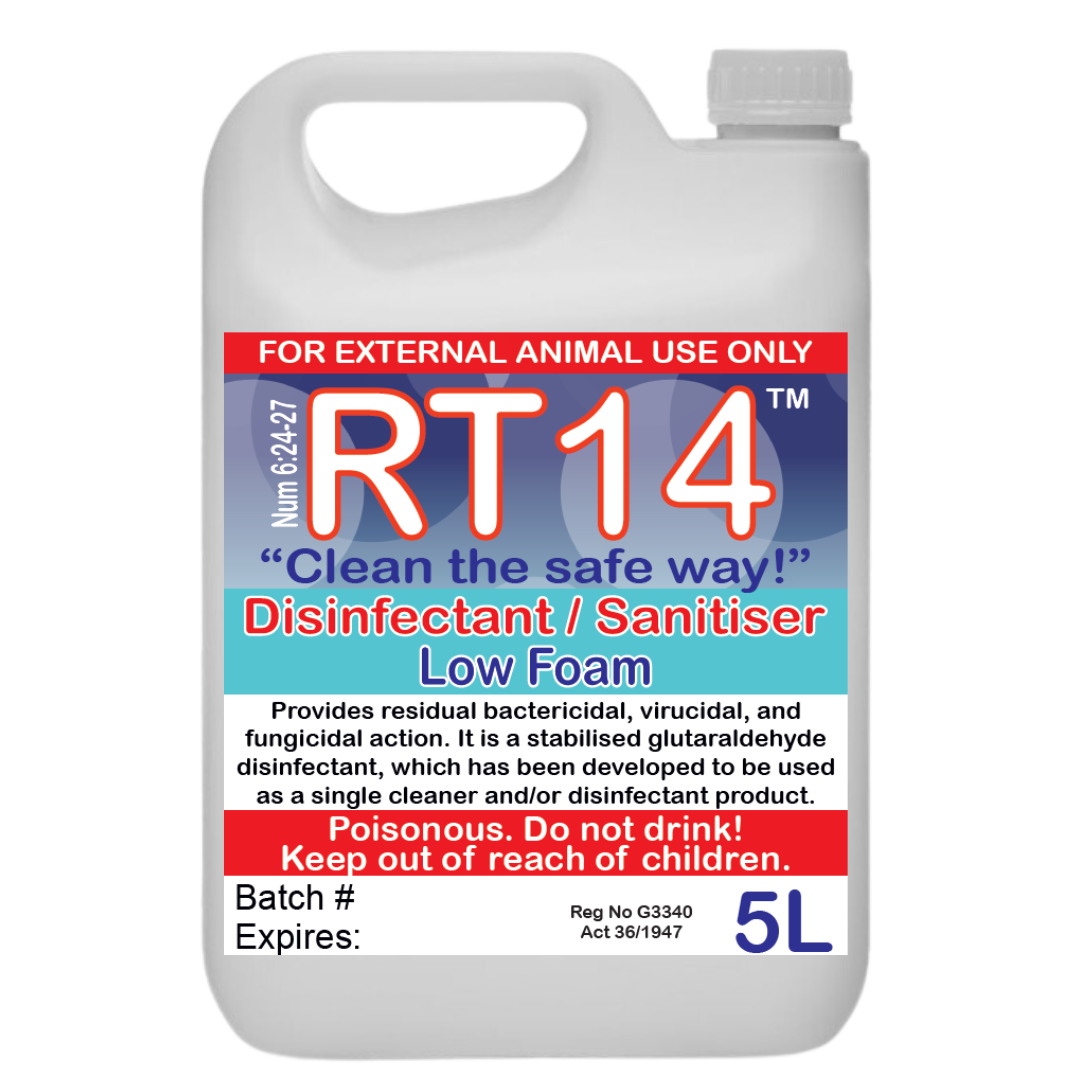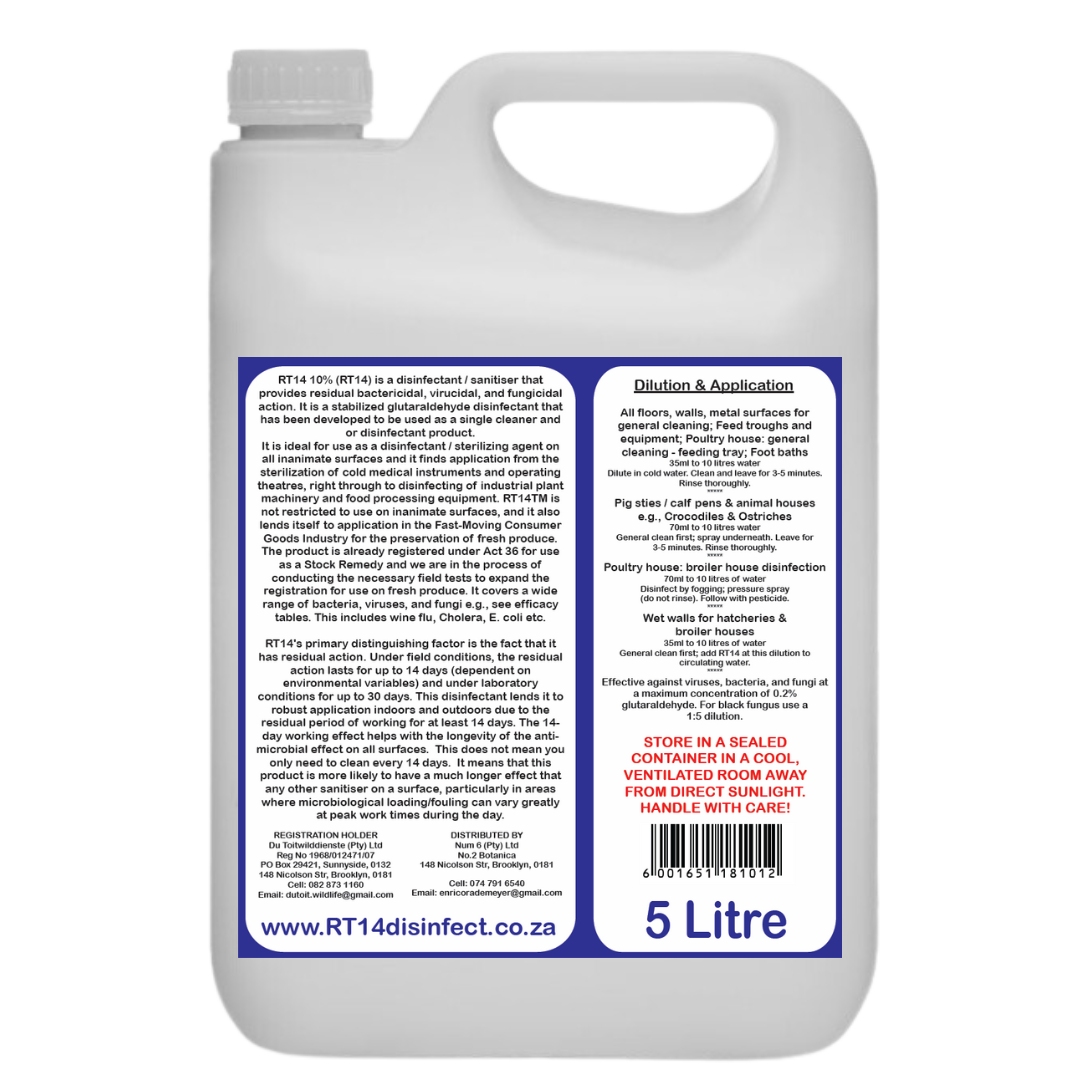RT14 – Low Foam
Provides residual bactericidal, virucidal, and fungicidal action. It is a stabilised glutaraldehyde disinfectant, which has been developed to be used as a single cleaner and/or disinfectant product.
“Clean the safe way!”


It is ideal for use as a disinfectant / sterilizing agent on all inanimate surfaces and it finds application from the sterilization of cold medical instruments and operating theatres, right through to disinfecting of industrial plant machinery and food processing equipment. RT14 is not restricted to use on inanimate surfaces, and it also lends itself to application in the Fast-Moving Consumer Goods Industry for the preservation of fresh produce. The product is already registered under Act 36 for use as a Stock Remedy and we are in the process of conducting the necessary field tests to expand the registration for use on fresh produce.
It covers a wide range of bacteria, viruses, and fungi e.g., (see efficacy tables). This includes swine flu, Cholera, E.coli etc.
RT14’s primary distinguishing factor is the fact that it has residual action. Under field conditions, residual action lasts for up to 14 days (dependent on environmental variables and under laboratory conditions for up to 30 days. This disinfectant lends itself to robust application indoors and outdoors due to the residual period of working for at least 14 days. The 14-day working effect helps with the longevity of the anti-microbial effect on all surfaces. This does not mean you only need to clean every 14 days. It means that this product is more likely to have a much longer effect than any other sanitiser on a surface, particularly in areas where microbiological loading/fouling can vary greatly at peak work times during the day.
- STORE IN A SEALED CONTAINER IN A COOL, VENTILATED ROOM AWAY FROM DIRECT SUNLIGHT
- HANDLE WITH CARE!
- FOR EXTERNAL ANIMAL USE ONLY
- POISONOUS. DO NOT DRINK!
- KEEP OUT OF REACH OF CHILDREN
EFFECTIVE AGAINST THE FOLLOWING ORGANISMS AND DISEASES
! Aspergillus niger
! Bacillus anthracis (anthrax)
! Clostridium bifermentas (tetanus)
! E.Coli
! EDS (Egg Drop Syndrome)
! Gumboro disease
! Mycobacterium spp (Tuberculosis)
! Newcastle disease
! Penicillium chrysogenum
! Foot and mouth disease
! Proteus rettgeri
! Proteus vulgaris
! Pseudomonas aeruginosa
! Saccharomyces cerevisiae
! Salmonella pullorum
! Salmonella typhi
! Staphylococcus aureus
! Trichomonas gypseum
APPLICABLE LOCALITIES, DILUTIONS & METHOD APPLICATION
- All floors, walls, metal surfaces, and general cleaning | 35ml to 10 litres water | Dilute in cold water. Clean and leave for 3-5 minutes. Rinse thoroughly.
- Feed troughts and equipment | 35ml to 10 litres water | Dilute in cold water. Clean and leave for 3-5 minutes. Rinse thoroughly.
- Foot baths | 35ml to 10 litres water | Dilute in cold water. Clean.
- Pig sties or calf pens and animal houses e.g., Crocodiles and Ostriches | 70ml to 10 litres water | General clean first; spray underneath. Leave for 3-5 minutes. Rinse thoroughly.
- Poultry: broiler house disinfection | 70ml to 10 litres water | Disinfect by fogging, and pressure spray. Do not rinse. Follow with pesticide application.
- Poultry house: general cleaning – feed tray | 35ml to 10 litres water | Dilute in cold water. Clean and leave for 3-5 minutes. Rinse thoroughly.
- Wet walls for hatcheries and broiler houses | 35ml to 10 litres water | General clean first. Add RT14 at this dilution to circulating water.